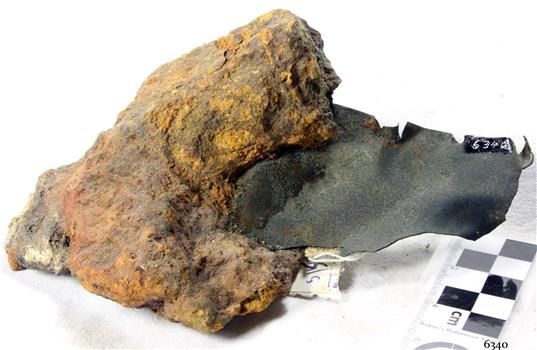Historical information
This object is a piece of Muntz or copper sheathing, a sheet of metal used for lining a ship's hull as protection from sea worm or muntz worm. It has been salvaged from the Schomberg ship wreck.
The muntz has been damaged by reaction of the metals to the sea. It also has encrustations from the sea such as sand. Other damage, such as movement of the sea or objects in the sea, has caused the edges to break away or fold over.
ABOUT MUNTZ
The hulls of early timber sailing ships had a problem of being eaten through by the marine animals called Teredo Worms, sometimes called ‘sea worms’ or ‘termites of the sea’. The worms bore holes into wood that is immersed in sea water and the bacteria inside the worms digest the wood.
Shipbuilders tried to prevent this problem by applying coatings of tar, wax, lead or pitch onto the timber. In the 18th and 19th centuries ships were built with their hulls sheathed in sheets of copper or a combination of 60 percent copper and 40 percent zinc (called Muntz metal). The ships would be re-metalled periodically to ensure the sheathing remained effective.
In more recent times the ships are protected with a toxic coating.
ABOUT THE SCHOMBERG
When the ship Schomberg was launched in 1855, she was considered the most perfect clipper ship ever to be built. James Blaine’s Black Ball Line had commissioned her to be built for their fleet of passenger liners. At a cost of £43,103, the Aberdeen builders designed her to sail faster than the quick clippers designed by North American Donald McKay. She was a three masted wooden clipper ship, built with diagonal planking of British oat with layers of Scottish larch.
This luxury vessel was designed to transport emigrants to Melbourne in superior comfort. She had ventilation ducts to provide air to the lower decks and a dining saloon, smoking room, library and bathrooms for the first class passengers.
At the launch of Schomberg’s maiden voyage, her master Captain ‘Bully’ Forbes, drunkenly predicted that he would make the journey between Liverpool and Melbourne in 60 days. Schomberg departed Liverpool on 6 October 1855 with 430 passengers and 3000 tons cargo including iron rails and equipment intended the build the Geelong Railway and a bridge over the Yarra from Melbourne to Hawthorn.
The winds were poor as Schomberg sailed across the equator, slowing her journey considerably. She was 78 days out of Liverpool when she ran aground on a sand-spit near Peterborough, Victoria, on 27 December; the sand spit and the currents were not marked on Forbes’s map. Overnight, the crew launched a lifeboat to find a safe place to land the ship’s passengers. The scouting party returned to Schomberg and advised Forbes that it was best to wait until morning because the rough seas could
easily overturn the small lifeboats.
The ship’s Chief Officer spotted SS Queen at dawn and signalled the steamer. The master of the SS Queen approached the stranded vessel and all of Schomberg’s passengers were able to disembark safely.
The Black Ball Line’s Melbourne agent sent a steamer to retrieve the passengers’ baggage from the Schomberg. Other steamers helped unload her cargo until the weather changed and prevented the salvage teams from accessing the ship. Local merchants Manifold & Bostock bought the wreck and cargo, but did not attempt to salvage the cargo still on board the ship. They eventually sold it on to a Melbourne businessman and two seafarers. After two of the men drowned when they tried to reach Schomberg, salvage efforts were abandoned.32
In 1975, divers from Flagstaff Hill, including Peter Ronald, found an ornate communion set at the wreck. The set comprised a jug, two chalices, a plate and a lid. The lid did not fit any of the other objects and in 1978 a piece of the lid broke off, revealing a glint of gold. As museum staff carefully examined the lid and removed marine growth, they found a diamond ring, which is currently on display in the Great Circle Gallery.33 Flagstaff Hill also holds ship fittings and equipment, personal effects, a lithograph, tickets and photograph from the Schomberg. Most of the artefacts were salvaged from the wreck by Peter Ronald, former director of Flagstaff Hill.
Significance
This piece of muntz sheathing is representative of building methods and materials used in late 19th and early 20th century ship building.
The munts is also significant for its association with the Schomberg, which is on the Victorian Heritage Register (VHR S612), has great historical significance as a rare example of a large, fast clipper ship on the England to Australia run, carrying emigrants at the time of the Victorian gold rush. She represents the technical advances made to break sailing records between Europe and Australia.
Flagstaff Hill’s collection of artefacts from the Schomberg is significant for its association with the shipwreck.
The collection is primarily significant because of the relationship between the objects, as together they have a high potential to interpret the story of the Schomberg. It is archaeologically significant as the remains of an international passenger Ship. It is historically significant for representing aspects of Victoria’s shipping history and for its association with the shipwreck and the ship, which was designed to be fastest and most luxurious of its day
Physical description
Copper sheathing or Muntz metal in concretion. Recovered from the wreck of the Schomberg.
Subjects
- warrnambool,
- shipwrecked-coast,
- flagstaff-hill,
- flagstaff-hill-maritime-museum,
- maritime-museum,
- shipwreck-coast,
- flagstaff-hill-maritime-village,
- schomberg,
- shipwrecked-artefact,
- clipper ship,
- black ball line,
- 1855 shipwreck,
- aberdeen clipper ship,
- captain forbes,
- peterborough shipwreck,
- ss queen,
- copper sheathing,
- muntz,
- muntz metal,
- teredo worms,
- sea worms,
- sea termites,
- ship building,
- 19th century sailing ships

